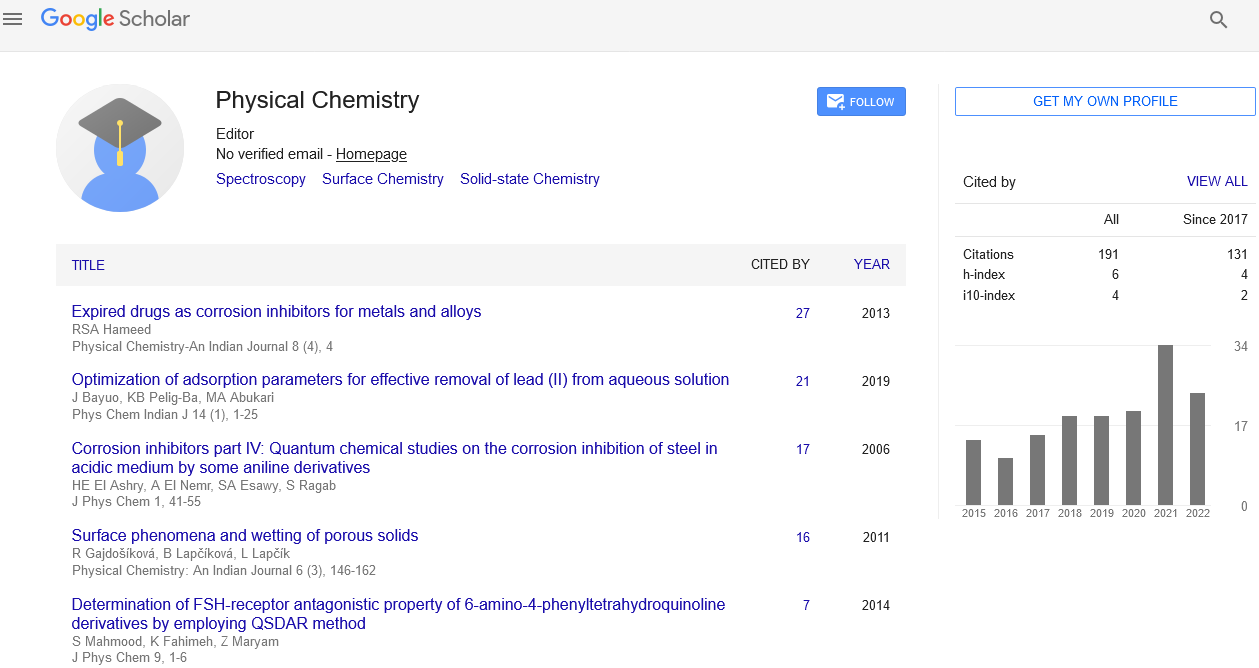Short communication
, Volume: 17( 2)Producing New Recyclable Materials by Combining Monomer Design with Physical Organic Chemistry.
- *Correspondence:
- Eddie Martin
Editorial Office, Physical Chemistry: An Indian Journal, West End Southampton Hampshire, UK
E-mail:ediemartin44@aol.com
Received date: March 10, 2022, Manuscript No. tspc-22-73995; Editor assigned: March 13, 2022, PreQC No. tspc-22-73995 (PQ); Reviewed: March 25, 2022, QC No. tspc-22-73995 (Q); Revised: April 4, 2022, Manuscript No. tspc-22-73995 (R); Published: April 7, 2022, DOI: 10.37532/2320–6756.2022.17(2).167
Citation: Martin E, Jane M, Jenson K., et al. Producing New Recyclable Materials by Combining Monomer Design with Physical Organic Chemistry, Phys. Chem.: Indian J..2022;17(2).167.
Abstract
For this goal, a variety of monomer families have been investigated, from phthalaldehydes to dithiolenes, with a focus on Ring-Opening Polymerization (ROP) of low strain cyclic monomers. Chen and coworkers' study, which was especially outstanding, demonstrated totally recyclable systems for -butyrolactone and its annulated derivatives that have characteristics similar to those of common thermoplastics. The Lu group built on the success of lactones by creating hydroxyproline-derived thiolactone monomers that were capable of quick and reversible ROP to produce Polythioesters (PTEs). Thioesters have substantially higher rates of transesterification than their oxoester counterparts, which makes it easier to produce and disassemble low ceiling temperature polymers quickly.
Keywords
Polymers; Entropy; Polytheoesters; Molecular dynamics; Density functional theory
Short Communication
A major difficulty that humanity is currently experiencing is the requirement for materials that are made from renewable resources and the creation of a circular economy for plastics. Given our reliance on these fundamental components, the long-term fate all too frequently entails scattering single-use products throughout the environment or dumping them in landfills. Polymer chemists are actively working toward answers through the invention of new polymer classes that can be effectively converted back to the original monomers, even though this issue will require an united effort across numerous scientific fields to address. This recycling technique is appealing because it eliminates the difficulties associated with conventional procedures, which might cause material performance to decline during usage, processing, or due to contamination with co-mingled goods. Even while pyrolytic or chemolytic techniques can be used to regenerate monomers, finding polymer systems that can undergo end-to-end depolymerization to completely return to their original monomers may be the most elegant strategy being sought. A polymer with a low ceiling temperature, or the temperature at which polymerization and depolymerization proceed at equal rates, is the main requirement to accomplish this challenging task. Due to very exothermic propagation phases, polymerizations are typically very energetically beneficial (Gp 0, exergonic). A lesser entropic penalty of combining the independent translational motions of individual monomers into a collective trajectory of the connected polymer chain almost invariably inhibits this forward process. An interesting scenario arises when the enthalpic driving force is reduced, making it similar in magnitude to the entropic penalty (ΔHp=TΔSp)[1]. This enables control over the monomer-polymer equilibrium by modulating the temperature or concentration of the system which, in principle, can be exploited to provide either polymerization or depolymerization on demand. In the hope of using these products in real-world applications, this results in the added challenge of designing low ceiling temperature polymers that retain integrity during daily use or at elevated temperature.
A number of monomer families have been explored for this purpose, ranging from phthalaldehydes to dithiolenes, and considerable focus has been placed on Ring-Opening Polymerization (ROP) of low strain cyclic monomers [2-4]. Particularly impressive work by Chen and co-workers showcased fully recyclable systems for γ-butyrolactone and annulated derivatives that possess properties comparable to commodity thermoplastics [5, 6]. The Lu group built on the success of lactones by creating thiolactone monomers generated from hydroxyproline that could undergo quick and reversible ROP to produce Polythioesters (PTEs) [7]. Thioesters exhibit substantially faster rates of transesterification than their oxoester counterparts, which makes it easier to produce and disassemble low ceiling temperature polymers quickly. In each of these cases, catalysis offers a way to lower the polymerization temperature and produce polymers with large molecular weights despite having a small enthalpic advantage. After the catalyst is removed, the polymers lose a simple avenue for further equilibration and acquire kinetic stability. They can then strengthen their resilience by creating cyclic systems or covalently altering the chain end. Lu and coworkers enhance their research on PTEs in this issue of Chem by showcasing the usefulness of -thiolactones in reversible ROP. From the standpoint of ring strain, the utilisation of a four-membered thiolactone initially appears paradoxical and contrasts sharply with other methods for reversible ROP that made use of greater ring diameters. It is true that thiolactones have been observed to polymerize in the past, but they lack life characteristics or reversible behaviour. The authors found naturally occurring D-penicillamine as a commercially available starting material to create monomers with two methyls on the same carbon within the -thiolactone ring in order to curb these undesired routes. The Thorpe-Ingold effect, also known as the gem-dimethyl effect in physical organic chemistry, is a phenomena that occurs when methyl substituents improve the rate of cyclization and make the depolymerization pathway easier. Starting from Dpenicillamine, a variety of β-thioester monomers were readily prepared in a one-pot operation on multi-gram scales. Simply subjecting the monomers to a thiol initiator with a basic amine catalyst effected bulk polymerization at room temperature to give PTEs with molecular weights in excess of 70 kg/mol and low dispersities (D<1.3) in a matter of hours. Equilibrium studies at different temperatures revealed the polymerization to be nearly thermoneutral (ΔGp= −0.24 kcal/mol), and treatment of the PTEs with the same amine catalyst in dilute solution fully regenerated the β-thioester monomers with no erosion of chirality. Remarkably, the polymerization was found to be highly living in both the forward and backward direction through kinetic studies. Although controlled polymerizations are now commonplace, living behavior in depolymerization is rarely demonstrated without the generation of intermediate oligomeric fragments or side reactions. The monomer platform is quite open to the addition of functionality when considering prospective applications. The solubility and thermal characteristics of the penicillamine framework could be modified by derivatizing it with a range of carbamate side chains, and the polymer termini could be tailored by selecting the right thiol initiator and alkyl halide capping agent. The orthogonality of polar and radical sulfur-based chemistries was highlighted by the use of a monomer with an olefin-containing side chain to enable post-polymerization functionalization via thiolene coupling with aliphatic or charged sulphate groups. The PTEs were semi-crystalline and thermally stable in the absence of base up to temperatures close to 200°C, even with an open thiol chain-end, as a result of the chirality of the monomer. Due to their stability, polymers might be processed into melt-drawn fibres or clear hot-pressed films without any apparent breakdown.
In addition to the synthetic research, Molecular Dynamics (MD) simulations and Density Functional Theory (DFT) computations gave precise insights into the function of the gem-dimethyl substitution through comparison with an unsubstituted cysteine analogue. The propagating thiol chain-end and backbone thioesters' increased steric hindrance significantly raises the energy barrier for transesterification, confirming the polymerization's almost thermoneutral nature and explaining the high levels of livingness seen in all polymerizations. All particle MD reenactments show the additional methyl bunches likewise prompts significant changes to the ground state calculation of the chain-end in which the most populated conformer arranges the proliferating thiolate in closeness to the as of late opened thioester. This inclines the chain-end to cyclize back to a shortened polymer chain, notwithstanding the high ring-kind of the 4-membered ring, or to track down one more monomer for polymer development. This technique acknowledges a considerable lot of the objectives required for a round monomer economy: a normally inferred beginning material that holds extraordinary commitment for the versatile creation of monomers that can polymerize and depolymerize on request. Besides, the imaginative utilization of the diamond dimethyl impact to revamp the thermodynamic scene of β-thiolactone polymerization features the out-of-the-container thinking required in the plan of future recyclable polymer frameworks. It is guessed that this study will move the use of dynamic thioester bonds in new reversible polymerization stages and make ready toward cutting-edge materials for a feasible materials world.

